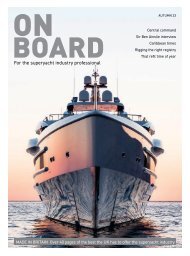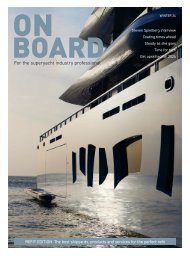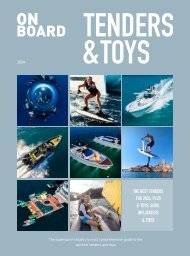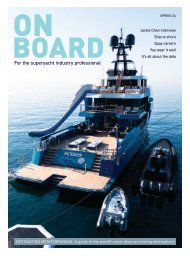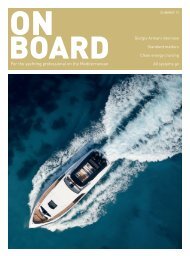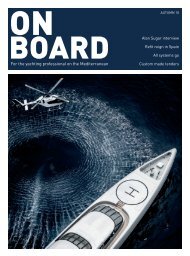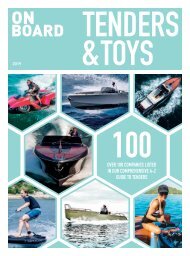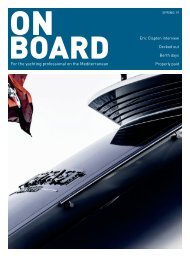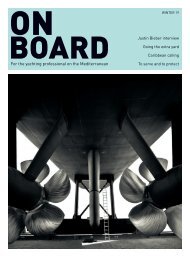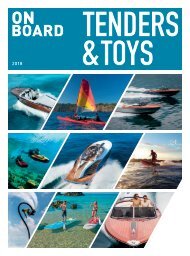ONBOARD Magazine - spring 2023
Get Onboard ONBOARD is aimed purely at the superyacht professional – whether onboard or shoreside. 100% of your spend will hit your targets on the Mediterranean from Palma in Mallorca, Barcelona, through France to Genoa and beyond together with Montenegro and the Aegean, plus the eastern seaboard of Florida. We hand deliver every copy to superyachts over 30m to make sure your message gets in to the hands of the decision makers on board. The publication is also delivered to relevant businesses around the ports and marinas together with shipyards. We also attend the major yacht shows in Monaco, FLIBS, METS, Boote Dusseldorf, Palma and MYBA for on site distribution. Plus, we post over 500 copies to relevant businesses not on the Mediterranean such as the UK, the Netherlands, Germany the rest of northern Europe and of course the USA and Caribbean. We work hard to develop a publication that all the crew and land based decision makers will read from cover to cover. An enjoyable and informative read for everyone means your message will be read. Talking about your brand, product, services and your team is essential and with our help, the message hits the right decision makers.
Get Onboard
ONBOARD is aimed purely at the superyacht professional – whether onboard or shoreside. 100% of your spend will hit your targets on the Mediterranean from Palma in Mallorca, Barcelona, through France to Genoa and beyond together with Montenegro and the Aegean, plus the eastern seaboard of Florida. We hand deliver every copy to superyachts over 30m to make sure your message gets in to the hands of the decision makers on board.
The publication is also delivered to relevant businesses around the ports and marinas together with shipyards. We also attend the major yacht shows in Monaco, FLIBS, METS, Boote Dusseldorf, Palma and MYBA for on site distribution. Plus, we post over 500 copies to relevant businesses not on the Mediterranean such as the UK, the Netherlands, Germany the rest of northern Europe and of course the USA and Caribbean.
We work hard to develop a publication that all the crew and land based decision makers will read from cover to cover. An enjoyable and informative read for everyone means your message will be read.
Talking about your brand, product, services and your team is essential and with our help, the message hits the right decision makers.
Create successful ePaper yourself
Turn your PDF publications into a flip-book with our unique Google optimized e-Paper software.
MY OPINION<br />
Bringing light to the deep<br />
Tinah Martin from Seabed 2030 looks at the importance of<br />
mapping our seabeds with the help of yacht owners<br />
Have you ever looked at a world map and wondered how<br />
much of the vast ocean has been discovered in detail?<br />
What type of landscape would it disclose if the entire<br />
water bodies surrounding the continents on earth were to be<br />
removed? With bathymetry maps, which present the measurement<br />
of depth of water in oceans, and provide information of the shape<br />
of the seafloor, these secrets would be no more.<br />
The Nippon Foundation-GEBCO Seabed 2030 Project has engaged<br />
with stakeholders from around the world to inspire and bring<br />
together passionate ocean mappers and scientists to contribute<br />
to the General Bathymetric Chart of<br />
the Oceans (GEBCO). Despite the<br />
notable progress, with just over 20%<br />
of the ocean floor revealed in a high<br />
resolution map, including data from<br />
various sources (academia, industry,<br />
government, crowdsourced bathymetry<br />
initiatives), there is much yet still to do.<br />
People are at the centre of this huge<br />
enterprise, and their voices and expertise<br />
pave the way to achieving the definitive map of the world ocean floor.<br />
From explorers identifying remote areas to map to coordinating<br />
groups guiding and prioritising data collection efforts, it’s about<br />
a rising tide to lift all boats.<br />
For over a century, the effort to bring the light to the deep has<br />
gathered a community from across multiple marine related disciplines<br />
and sectors. Pioneers and more arduous researchers lead work<br />
to reveal the seafloor to the public. Methods to acquire data and<br />
ocean observation have evolved from lead lines to sophisticated<br />
hydrographic vessels equipped with high performing multi beams<br />
and other AUVs.<br />
Despite advancements in the mapping field, it is necessary to<br />
address the imbalance of capabilities around the world, hence<br />
the need to bridge the gaps in our communities. Enhancing<br />
access to data and technology through collaboration will advance<br />
Enhancing access to data<br />
and technology through<br />
collaboration will advance<br />
exploration and provide a better<br />
understanding of the ocean<br />
exploration and provide a better understanding of the ocean<br />
beyond national jurisdictions, which in turn will benefit the global<br />
community and science together.<br />
One example of collaborative working is equipping vessels with<br />
standard navigation devices or basic data loggers to record<br />
depth when transiting from port to port. This approach can be<br />
perpetuated within the maritime community to demonstrate how<br />
a slight change in routine operations can impact our collective<br />
knowledge of the ocean.<br />
Vessels can coordinate their data<br />
collection with one of Seabed 2030’s<br />
Regional Data Centres and the<br />
International Hydrographic Organization’s<br />
(IHO) Data Centre for Digital Bathymetry<br />
(DCDB). Crowdsourced bathymetry plays<br />
a vital role in helping us advance and<br />
achieve the ambitious goal of a gully<br />
mapped ocean floor, whilst also promoting<br />
open access data policy.<br />
From designing marine protected areas, to understanding key<br />
components of the dynamics of fisheries, to ocean modeling, geohazard<br />
assessment, marine biodiversity conservation and safety<br />
of navigation, the description of the topographic characteristics<br />
of the ocean floor contribute tremendously to decision making<br />
when it comes to the sustainable use of our oceans.<br />
After all, we can only manage what we know. How would we be<br />
able to protect the richness of the deep sea without investigating<br />
and making the knowledge accessible, if not investing in the<br />
strength of our communities?<br />
The Nippon Foundation-GEBCO Seabed 2030 Project is endorsed<br />
under the UN Decade of Ocean Science for Sustainable Development.<br />
For more details on how to join this initiative visit<br />
www.seabed2030.org<br />
<strong>ONBOARD</strong> | SPRING <strong>2023</strong> | 7




